|

Only man - not gods, nor
demons in any case, nor animals or birds - can win liberation by proper and necessary
religious practice. The highest aim of human life is liberation. To accomplish this aim,
Bhagvan Mahavira showed the path of religious practice.
The simple meaning of the
path of religious practice is to folllow the code of conduct.
The code of conduct for
monks - nuns - is to observe the five mahavratas (great vows) and for the Srakakas and the
Sravikas it is observance of the twelve vratas (vows). To make the conduct of the monks
and the Sravakas purer and firmer, Bhagvan Mahavira laid down the code of food to be taken
(Aharasamhita), the code of movement (Asta Pravacana mata), and also the code of thoughts
(reflections).
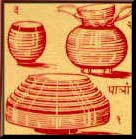 The
code of Food (Aharasamhita) The
code of Food (Aharasamhita)
1.
Boiled water - The monks,
nuns, Sravakas and Sravikas should always drink boiled water.
What modern science has
discovered now, the great Tirthankaras proclaimed thousands of years ago. It was that
water contains innumerable bacteria. Many living beings are killed by drinking water with
bacteria and many physical diseases appear. For this reason, public
propaganda is
undertaken for drinking boiled water at the time of epidemics like cholera, malaria, etc.
Boiled water should be taken to avoid violence and diseases. Raw water should be used only
after straining it. By drinking strained and boiled water one can save oneself from the
sin of violence and probable diseases.
2. Giving up eating
of non-eatables.
There is a proverb - As is
the food, so is the eructation. If one has eaten sour food, his eructation would be sour.
Food and water have a definite effect on body, mind, behaviour and thought. That food and
water, the intake of which causes the mind to be excited, the feelings to be distorted and
the thoughts to be polluted, are considered non-eatable. Devotees and aspirants should
give up such food and water.
In Jainism a detailed study
has been made of non-eatable things. They are fully discussed in books like
‘Jiva-Vichara’. The following is a brief summary of non-eatables in general.
1. Eating meat : Meat-eating should be given up. Meat of small or
big creatures, fish and eggs should not be taken. (Medicines and things, wherein these are
used should also be avoided as far as possible.)
2. Bulbs, roots,
tuber - bulbs etc, should be
given up. There are innumerable living beings in bulbous vegetables. By these things
living beings die and the mind gets excited. There are 22 types of bulbs like onion,
ginger, radish, brinjal, etc. Blood becomes warm by eating these things. The mind gets
excited easily and feelings get polluted.
3. Prohibition - Innumerable baecteria are killed in the
production of wine. By drinking wine, not only does killing of bacteria take place, but
also the drunkard loses his discretion and takes to unworthy things. His intellect gets
blunted and feelings get quickly excited.
In order to keep body and
mind cool, healthy and free from sin, eating meat, bulbs etc., and consumption of wine
should be given up for the whole life.
4. Giving up eating
at night - If possible both
food and water should be given up after sunset. If water cannot be given up, taking food
at night must be given up.
Hygiene also says that food
taken after sunset is not properly digested. Non-digestion of food leads to diseases like
dyspepsia, constipation, etc. If the stomach is disturbed, surely one cannot worship god
with a calm and tranquil mind.
At night many small insects
are produced and they die. If we take food at night, many small insects are killed. Eating
at night should be given up to save oneself from the sin of violence and also to keep
oneself healthy.
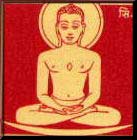 Types of
Penance (Tapas) Types of
Penance (Tapas)
Austerities
have a special place and are unavoidable.
The first Tirthankara
Risabhdeva fasted continuously for 400 days. The last Tirthankara Bhagvan Mahavira
performed various austerities for twelve and half years. Austerities of various types are
performed to control the senses and the mind. Austerities destroy karma, make the soul
pure and free from selfishness.
Sramana Bhagvan Mahavira
divided austerities into two types-
1. External
2. Internal.
External Austerities are
concerned with the body of the aspirant. Physical signs are visible on the person who
performs external penance. Renunciation and tolerance are the main characteristics of this
type of penance.
There are 6 types of this :
1. Anasana
(Non-eating) - One should give
up 4 types of food, viz. food-grains, water, dry fruits and betelnuts.
This fasting has 2 types :
(1) Fasting for a limited period, (2) Fasting for the whole life.
There are five main types
of limited fasting.
Sreni tapa, Pratara tapa,
Ghota tapa, Varga tapa, and Vargavarga tapa. Over and above these, the following are the
most current types of limited fasting :
(A) Upavasa -
To give up both food and water or only
food for the whole day is called upavasa (fast).
(B) Chaththa -
To give up food and water or only food
continuously for 2 whole days is called chaththa.
(C) Aththama - To give up food and water or to give up
only food continuously for 3 whole days is called Aththama.
(D) Aththai - To give up food and water or only food
continuously for eight days is called Aththai.
(E) Masaksamana - To give up food and water or only food
continuously for one whole month is called Masaksamana.
There are two types of
fasting till death -
(A) Bhatta Pratyakhyana. Herein food of 4 types, viz., (1)
Food grains (2)
Water (3) Dry fruits, sweetmeats, etc. (4) Betel leaves etc. is to be given up
(B) Padopagamana.
In this type one has to give up food of
all the 4 types, sit still on a seat and meditate on the soul.
Special Features :
Only boiled water is to be taken during
fasting. Water also is to be given up after sunset. Water is to be taken at one place
while sitting.
The Giving up of food and
water for the whole day is called ‘Cauvihara’ upavasa.
This penance is especially
performed in the Paryusana. In this Parva devotees in a large number perform the penance
of aththai, or masaksamana.
2. Unodari - To eat and drink less than what hunger
demands.
3. Vrttisanksepa -
To lessen the number of things for
bhogopabhoga, eating and drinking and decrease daily necessities.
4. Rasatyaga -
One should give up food-materials and
toiletries, which would spoil the mind and render it unfit for mediation. Meditation on
the ‘nine padas’ is very much inspiring and encouraging.
5. Kayaklesa -
An experiment to test whether peace,
steadiness and tranquility of mind remain undisturbed even on unhappy
occasions. To walk
with bare footed and bare headed even in severe heat, to meditate bare - bodied in severe
cold, to meditate for hours, while sitting or standing at a particular place, are
kayaklesa penances.
6. Samlinata -
The mind often entertains bad thoughts.
The senses follow bad conduct. To prevent the mind running away to bad thoughts and
conduct and divert it to good thoughts and conduct is called samlinata penance.
 Abhyantara
tapa (Internal penance) Abhyantara
tapa (Internal penance)
This penance
is mainly concerned, with the mind of the aspirant. Internal (mental) good thoughts are
very significant in this penance. These thoughts cannot be seen; this penance is therefore
called ‘Internal’. There are 6 types of this penance.
(1) Prayaschitta
(repentance) -
A man commits
mistakes knowingly or unknowingly, he commits sins or faults. To repent for such sins or
faults wholeheartedly, to go to a preceptor and confess one’s sins with tearful eyes,
to seek punishment for these sins and to vow never to commit such sins in future is called
‘Prayaschitta’.
(2) Vinaya
(courtesy) - To respect, to
honor and to praise the virtues of all elderly people - saints, noble persons, who are
elder in age, who are more learned and virtuous. This is called Vinaya (showing courtesy).
(3) Vaiyavacca
(service) - To serve in
various ways the learned, the acarya, the upadhyaya, the monk, the nun, and elderly, old
and sick people is service.
(4) Svadhyaya
(self-study) - To study books
which would inspire and give mental strength to make the soul pure and unselfish. and
would strengthen good thoughts and good conduct is ‘Svadhyaya’ (self-study).
Books should be read or sermons heard from qualified worthy preceptors.
(5) Dhyana
(mediation) - To think and
mediate on God with a steadfast mind. This mean sitting firmly and immovably on an
uncontaminated seat or standing. This is called ‘Dhyana’.
(6) Utsarga (giving
up) - One should mediate on
god, after giving up all external activities of the household and business, and giving up
all other thoughts except those of god is ‘Kayotsarga’. Kayotsarga is very
popular as a penance or mediation. To give up attachment to the body and to become one
with god are the main characteristics of this penance.
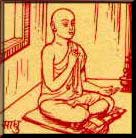 Special
types of Penance (Tapas) Special
types of Penance (Tapas)
Among
external types of penance, Anasana (fasting) is the first penance and Rasatyaga is the
fourth penance. Making those two penances the foundation-stone, special penances have been
planned. They are as follows :
Varsitapa (yearly
penance) - This penance lasts
for full 400 days. For the ascetic every altemate day is a fast day and on every alternate
non-fast day, he takes meals only twice.
The last fast of this
penance is broken with sugar-cane juice.
The first Tirthankara Sri
Risabhadeva fasted continuously for one year and broke his fast with sugar-cane juice.
Hence this penance is performed in imitation of the penance of Rsabhadeva.
Every year thousands of
devotees perform this penance with pleasure.
2. Navpada oli - Navapadas are most important in this
penance. It is intended to make the soul pure and free from selfishness, It begins on the
8th day of the dark half of Falguna and ends on the 3rd day of the bright half of
Vaishakha.
The soul becomes pure and
bright by concentrated mediation on the nava padas. A detailed guidance has been given
for the worship and mediation of these ‘Navapadas’. These are as follows :
1. Arihanta - He is the Tirthankara worshipped with
absolute faith by the Jains. He who has conquered completely attraction, hatred and
attachment and is the most worthy of worship is ‘Arihant’. He is known by
various holy names like ‘Vitaraga’, ‘Tirthankara’, ‘Arhata’,
‘Jina’, ‘Jineshvara’, etc.
2. Siddha - Those liberated, enlightened formless
souls, free from faults, who have destroyed all karmas, good or bad, and have attained the
nature of the God, are called ‘Siddhas’.
3. Acarya - The senior leader of a group of Jain
monks is called an ‘acharya’. That Jain monk who is distinguished in knowledge,
conduct and observance of self-control, who is capable and strong enough to carry the
responsibility of religious management, is given the supreme title of ‘Acharya’.
The life-style of such an ‘acarya’ is such that his behavior is silent but
gives eloquent inspiring discourses. In the long absence of Arihanta, the Acharya carries
on the responsibilities of the fourfold sangha - the monks, the nuns, the Sravakas and the
Sravikas.
4. Upadhyaya -
The Jain monk, who is extraordinary in
knowledge conduct and self-control; who has studied religious and philosophical works
fully, who has mastery over the scriptures and the ability to teach them to others is
called ‘Upadhaya’. This is also a title.
5. Sadhu -
The initiated ascetic who observes the
five great vows laid down by Bhagvan Mahavira and who engages in self mediation is called
a ‘Sadhu’.
Jainas call these
five-Arihanta, Siddha, Acharya, Upadhyaya and Sadhu, as the five Paramesthis. They worship
these five and have great and unstinted faith in and respect for them.
6. Darsana -
It means unshakeable and firm faith, in
the categories for self-mediation as laid down by Bhagvan Mahavira, as well as the path,
is called ‘darsana’.
This darsana is known as
samyakta, samakita and samyagdarsana.
7. Janana - ‘Janana’ is knowledge which
inspires one to know and realize the soul. Knowledge is useful in dispelling darkness, in
the form of attachment, hatred and delusion.
8. Caritra -
A soldier in an army guards the
frontiers of the country with great watchfulness, without even taking a nap. Similarly, to
live in self-hood, to become one with the soul with vigilance, without getting tired or
bored or remaining careless, is called ‘Caritra’.
9. Tapa - Ritual performance or ceremony to
control the emotions of the body and the mind, thoughts and conduct is called
‘tapa’.
The ceremonial worship of
these ‘navapadas’, continuously for nine days, is called Navapada oli. Coarse
food, without ghee, milk, curds, jaggery, oil and fried things, is taken and that too only
once a day during these nine days.
Taking such food once a
day, is called ‘Ayambila tapa’.
The worship of
‘navapadas’ is performed twice a year from the 7th to the 15th day of the bright
half of aso and of caitra.
This tapa is to be
performed by a person at least for 4 years and a half.
In addition to Varsi Tapa
and Navpada oli, there are more than 100 types of penances, like Vardhamana tapa,
Candanabala tapa, Aksayanidhi, tapa etc.
Boiled water is used in all
these types of penance.
In all these types of
penance, visiting a temple, worship of the Jina, saluting the preceptor, listening to
religious discourses, the morning and the evening pratikarmanas, chanting, mediation, etc.
are to be performed. "Vigais" and "Mahavigais" spoil our feelings.
Oil, Ghee, jaggery and fried things are "Vigais" while meat, butter, wine and
honey are ‘Mahavigais’. They should be abstained from.
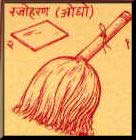 Conduct
above Movement Conduct
above Movement
Sramana
Bhagvan Mahavira has given clear guidance about vihara so that an aspirant can follow his
religious practice with simplicity, firmness and purity of mind.
Bhagvan has laid down for
the aspirant rules about walking, talking and behaviour along with the types penance,
renunciation and the vows. Bhagvan has ordained that an aspirant should properly observe
the five samitis and the three guptis.
 Samiti Samiti
Samiti means
controlling various activities about walking, talking etc. These are five in number.
1. Irya Samiti -
An aspirant should take to all
activities of walking, sitting and getting up in such a way that nobody is hurt. One
should walk carefully so that no insects are crushed under one’s feet, nobody is
pushed or nobody is stumbled.
2. Bhasa Samiti -
Activity of speaking. To keep silent as
long as possible. One should speak, if it is absolutely necessary. One should not speak
such words as would hurt or wound the heart. One shall always speak good, measured and
sweet words.
3. Esana Samiti - The activity about arranging vessels for
food and drink. The utensils for food and drink should be properly washed, cleaned and
arranged at an undefiled place. A dirty vessel should not be used. A half-filled glass of
water should not be kept. (The observance of this samiti is compulsory for monks and
nuns.)
4. Adananiksepana
Samiti - The activity about
arranging things, for daily use e.g. clothes and books should be placed in such a way that
no living being is hurt.
5. Paristhapanika
Samiti - The activity of
throwing. Mucus and phlegm should be thrown is such a manner that no living being is
killed under its weight. One should be very careful, while throwing dirt or food-refuse or
water.
 Gupti Gupti
They are 3
types of Gupti. Gupti means to check and divert the activities of mind, speech and body to
good channel.
1. Manogupti -
Man thinks with his mind. He entertains
good and bad thoughts. If the mind entertains bad or improper thoughts, it should be
checked and one should divert it to good thought. The mind should be kept engaged in
mediation of the soul.
2. Vacanagupti -
Man utters good or bad words. He speaks
both worthy and unworthy words. One should not utter bad words. Bitter and cruel words
should not be spoken. Inauspicious and harmful words should not be spoken. One should
speak good, measured, agreeable and inspiring words.
3. Kayagupti - Man undertakes many physical activities,
both good and bad, necessary and unnecessary. The body is the chief means of religious
practice. Physical activity that would be helpful in self - realization, should be
resorted to. One should meditate on the soul, sitting alert and straight on a seat.
The observance of these
five samities and three Guptis is compulsory for monks and nuns. They observe these eight,
in addition to the observance of the five great vows.
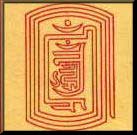 The Code
of Deep Thought The Code
of Deep Thought
Deep
thoughts play an important part in the formation of one’s personality. Man entertains
good or bad thoughts. These thoughts have a definite influence on the body, the mind and
the soul.
To think continuously, to
contemplate in totality on one thought only is called Bhavana (Reflection). One can
himself rise to godliness by reflecting on a Bhavana.
Sramana Bhagvan Mahavir
laid down a code of deep thoughts so that mediation on the soul can be speedy and
effective. He has described 16 chief and important bhavanas out of many.
The aspirants for the
uplift of the soul should reflect on these bhavanas daily, regularly and continuously.
They are as follows :
1. Anitya Bhavna -
Nothing is permanent and immortal in
this world. A soul is born and dies. Death comes at any moment. There are deaths and
deaths of young and old people. Relations break. Relation change. Whatever form is there
in the morning, does not continue to be the same till the evening.
The form in the evening
changes the next morning. Thus all forms, relations, etc. of this world are impermanent,
transient and short-lived. So what is the meaning of showing attachment and selfishness
towards all these ? To think continuously in this manner is called ‘Anitya
bhavana’.
2. Asarana bhavana -
Somebody can help a man if he is overcome
by mental trouble, or has physical diseases or any other kind of trouble. A remedy for
unhappiness can be found. But nobody can share the pain, the agony and the anguish of that
unhappiness. Man him self has to suffer pain and anguish. Only religion, pointed out by
god can become a shelter and help one to overcome pain. To think continuously in this
manner is called ‘Asarana bhavana’.
3. Samsara bhavana -
Our worldly life means the circle of
births and deaths. The soul sometimes takes birth as a man, sometimes as a god, sometimes
as an animal or a bird. He is sometimes born as a resident of hell. It may happen that
whoever was a mother in the last birth may become a wife in this birth. Thus, relations go
on changing in a strange manner in this worldly life. What is the meaning and use of
living such a worldly life ? To think in this manner is samsara bhavana.
4. Ekatva bhavana - The soul has to traverse along the path
of life or death. He is born alone and lives alone. He alone experiences the fruits of
good and bad actions. He is alone among relations and friends. All relations in this
worldly life are selfish. Nobody is somebody’s relation or friend, To think in this
manner is ‘Ekatva bhavana.
5. Anyatva bhavana - The soul pervades and resides in all
minutest parts of the body, even hair and every particle of blood. But the body itself is
not the soul. The body and the soul are different. The body is mortal while the soul is
immortal. The form, the colour and the shape of the body change, while the soul is
unchangeable. Why take pleasure in the form and the complexion of the body ? To think in
this manner is ‘Anyatva bhavana’.
6. Asuci bhavana -
The beauty of the body may be very
attractive and enticing, but the whole body is made up of evil-smelling and dirty
substances. The excreta and urine are dirty and evil-smelling. The flesh and other parts
of the body are dirty and bad-smelling. Under the cover of the soft and beautiful skin,
there is a horrible dirt and evil smell. Why should one have attachment to such a dirty
and evil-smellihg body ? To think in this manner is ‘Asuci bhavana’.
7. Asrava bhavana -
Asrava means the way of entry. The way
of entry is the way to exit. One can enter and go out from open gates and open doors and
windows. Mind is such a door. Good and bad feelings and activities take place through the
mind. Bad feelings and activities make the soul dirty, while good feelings and activities
make the soul pure and transparent. To think in this manner is ‘Asrava bhavana’.
8. Samvara bhavana - Samvara means to stop, not to allow to
enter. To stop the mind, the speech and the body from showing bad feelings and behaviour
and to turn the mind, the speech and the body towards good conduct and good thoughts is
called ‘Samvara bhavana’.
9. Nirjara bhavana - Nirjara means to destroy. To destroy the
bonds of attachment, hatred and delusion. To lessen and slacken selfishness and
attachment. To destroy the mass of karmic particles covering the soul. The annihilation of
karmic particles takes place through penance. To think in this manner is ‘Nirjara
bhavana’.
10. Lokasvarupa
bhavana - To reflect on the
form of 14 Rajalokas on the nature of their production, maintenance and destruction is
‘Lokasvarupa bhavana.
11. Bodhidularlabha
bhavana - Everything is easy
and simple. One may get human birth. One may get all types of happiness and health. One
may get a good preceptor. To get all these is easy, but to get the knowledge of the soul
and to realize the soul is very difficult (though not impossible). To think on these lines
is ‘Bodhidurlabha bhavana.
12. Dharmasvakhyata
bhavana - The religion of the
soul is the only saviour. Liberation can be obtained through the worship of and meditation
on the soul. To think in this manner is ‘Dharmasvakhyata bhavana’.
Mere dry contemplation on
these 12 bhavanas is not enough. The underlying principles are to be put into practice.
(1) By
reflecting on ‘anitya bhavanas, one renounces attraction and attachment towards
temporary objects.
(2) By
reflecting on asarana bhavana, one accepts the shelter of only the religion of the soul.
(3) By
reflecting on the samsara bhavana, life is coloured deeply by non-attachment.
(4) By
reflecting on ‘ekatva bhavana’, one lives a life that would be beneficial to the
soul.
(5) By
reflecting on ‘anyatva bhavana’, one gives up attachment to the body and
realises the soul.
(6) By
reflecting on ‘asuci bhavana’, one gives up pleasures enjoyed by the body.
(7),(8) By
reflecting on ‘asrava bhavana’, and ‘samvara bhavana’, one unifies.
with the soul.
(9) By
reflecting on ‘nirjara bhavana’, karma particles are destroyed though penances.
(10) By
reflecting on the loka-svarupa-bhavana’, the spirit of I and mine, the feeling of
I-ness and my-ness is destroyed.
(11),(12)
By reflecting on ‘bodhidurlabha’ and ‘dharma svakhyata bhavanas’,
continuous untiring worship of the religion of the soul is performed.
13. Maitri bhavana - To have friendly relation with all the living
beings in the whole world, to be a friend of all and to be an enemy of nobody, is maitri
bhavana.
14. Pramoda bhavana -
Promada means to be happy.
To be happy at the happiness and progress of others, to experience joy on seeing people
more meritorious, learned and talented than us, to show affection towards the virtuous and
to praise virtues; to look only to merits and not faults. of others, this is pramoda
bhavna.
15. Karuna bhavana - To share the miseries of unhappy people
and that too, without any selfishness and expectation- to give warmth, courage and love to
such souls so that they can live happily and they can become steadfast in religion.
16. Madhyasthya
bhavana - One should not be
angry with those souls, who would not improve their lives, in spite of all efforts at
persuasion; one should think of their welfare, and yet remain impartial.
Literature Please read
‘Uttaradhyayaana sutra’, ‘Dasavaikalika sutra’, ‘Santa
sudharasa’, ‘Dharmabindu’, ‘Pancasaka’ etc. for further study.
|

